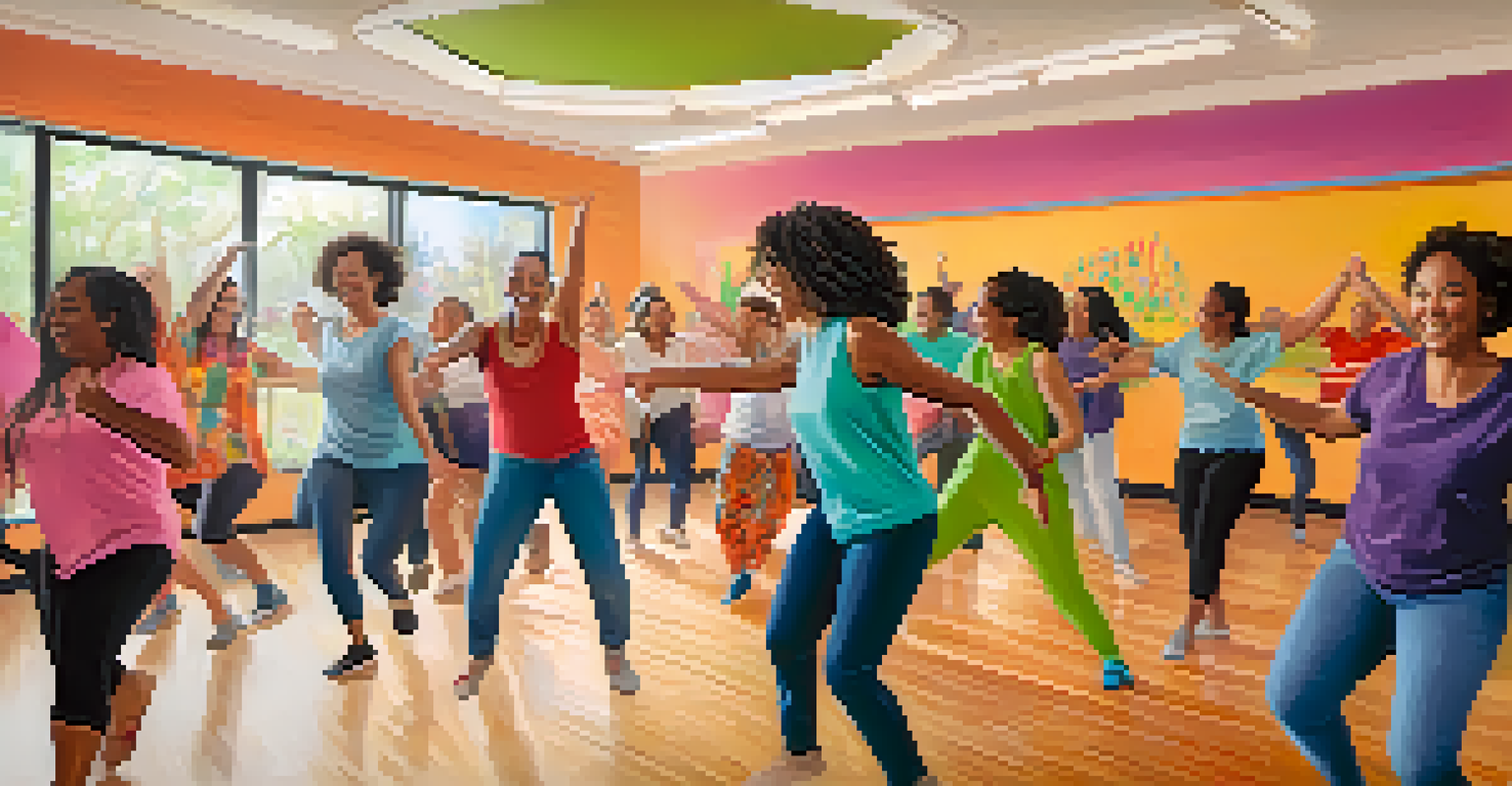Dance Therapy: A Healing Approach for Neurodiverse Minds

Understanding Dance Therapy and Its Benefits
Dance therapy is a unique form of expressive therapy that combines movement and creativity to promote emotional, mental, and physical well-being. It’s particularly beneficial for neurodiverse individuals, as it allows them to express feelings and experiences that might be difficult to articulate verbally. The rhythm and movement can help in releasing pent-up emotions, fostering a sense of freedom and joy.
Dance is the hidden language of the soul.
Unlike traditional talk therapies, dance therapy emphasizes body awareness and movement, making it a more natural outlet for those who might struggle with conventional communication. This approach not only enhances self-expression but also aids in improving social skills and reducing anxiety, making it a powerful tool for healing. Participants are often surprised at how liberating it feels to move and dance, reconnecting with their bodies in a positive way.
Moreover, dance therapy can cater to all ages and abilities, making it inclusive. Whether through structured dance routines or free movement, each session can be tailored to meet the individual’s needs, ensuring everyone finds their own voice through movement. This personalized approach can be particularly empowering for neurodiverse individuals, promoting a sense of accomplishment and self-worth.
The Science Behind Dance Therapy for Neurodiversity
Research has shown that dance therapy can significantly impact the brain's functioning, particularly for neurodiverse individuals who may experience challenges with social interaction and emotional regulation. Engaging in dance activates brain pathways that enhance mood and cognitive function. This physical engagement, paired with emotional expression, helps to create a holistic healing experience.

One of the key components of dance therapy is its ability to foster connections in the brain that are often underdeveloped in neurodiverse individuals. By participating in rhythmic movements and synchronized dancing, individuals can improve their motor skills while simultaneously enhancing their social interactions. It’s a beautiful interplay of body and mind, where each movement can lead to greater awareness and connection.
Dance Therapy Enhances Expression
Dance therapy provides a unique outlet for neurodiverse individuals to express emotions and experiences that may be difficult to convey verbally.
Additionally, the joy of dancing can release endorphins, which are natural mood lifters. For many participants, this means not only a reduction in anxiety and stress but also an increased sense of happiness and belonging. The scientific backing of these therapeutic benefits reinforces the idea that dance can be a powerful tool for healing, especially in neurodiverse communities.
How Dance Therapy Works for Neurodiverse Individuals
Dance therapy sessions often begin with warm-up exercises that help individuals ground themselves and become aware of their bodies. These exercises can be simple stretches or rhythmic movements that encourage participants to feel comfortable in their own skin. This initial phase is crucial as it sets the tone for a safe and inviting environment.
Movement is a medicine for creating change in a person's physical, emotional, and mental states.
As the session progresses, therapists may introduce structured activities that promote interaction and creativity. For instance, group dances can encourage teamwork and communication, helping individuals to connect with their peers while exploring new ways to express themselves. This social aspect is invaluable in building relationships and fostering a sense of community.
Finally, the sessions often culminate in a reflective space where participants can share their experiences and feelings about what they’ve expressed through movement. This debriefing can help solidify the connections made during the dance and encourage individuals to articulate their emotions more clearly. Ultimately, dance therapy is not just about movement; it’s about creating a safe space for healing and growth.
Real-Life Success Stories of Dance Therapy
There are numerous inspiring success stories that highlight the transformative power of dance therapy for neurodiverse individuals. For instance, a young girl with autism found her voice through dance, using movement to express emotions that were often lost in translation. Over time, she became more confident in social settings, showing how dance can bridge communication gaps.
Another compelling example is a teenage boy with ADHD who struggled with focus and anxiety. Through dance therapy, he discovered an outlet for his energy and learned techniques to manage his impulses. His ability to concentrate improved significantly, illustrating how movement can enhance cognitive functions and emotional regulation.
Holistic Benefits of Movement
Engaging in dance therapy activates brain pathways that improve mood and cognitive function, fostering emotional regulation and social interaction.
These success stories serve as powerful reminders of the potential that dance therapy holds. Each individual's journey is unique, but the common thread is the liberation and empowerment that movement can bring. Sharing these experiences not only sheds light on the effectiveness of dance therapy but also inspires others to explore this healing approach.
Finding a Qualified Dance Therapist
When considering dance therapy, it’s crucial to find a qualified therapist who specializes in working with neurodiverse populations. Look for professionals who have training in both dance therapy and an understanding of neurodiversity. This combination ensures that they can tailor sessions to meet the specific needs of individuals, fostering a supportive environment.
Many dance therapists hold certifications from recognized organizations, which can be an excellent starting point in your search. It’s also valuable to read reviews or testimonials from previous clients to gauge the therapist's effectiveness and approach. A good therapist will prioritize creating a safe and encouraging space where participants feel comfortable exploring their movements.
Additionally, don’t hesitate to reach out and ask questions during the initial consultation. This conversation can provide insight into their methods and philosophy, helping you determine if they’re a good fit. Finding the right therapist can make all the difference in the therapeutic journey, allowing neurodiverse individuals to flourish through the power of dance.
The Role of Family Support in Dance Therapy
Family support plays a significant role in the success of dance therapy for neurodiverse individuals. When families participate in the process, whether through attending sessions or discussing the experience at home, it creates a more robust support system. This involvement can help reinforce the positive changes that occur during therapy, making the journey more impactful.
Encouraging family members to engage in dance therapy together can also strengthen bonds and improve communication within the family unit. Sharing the experience of movement allows families to explore emotions together, fostering a deeper understanding of one another. This collaborative element can be particularly beneficial for neurodiverse individuals who may struggle with expressing their feelings.
Family Involvement is Key
Active family participation in dance therapy strengthens support systems and enhances communication, benefiting both the individual and the family unit.
Moreover, family members can learn strategies from dance therapy that they can apply at home, creating an environment that continues to promote emotional growth and healing. By being active participants in the therapeutic process, families not only support their loved ones but also enhance their own understanding of neurodiversity.
Conclusion: Embracing Dance Therapy for Healing
In conclusion, dance therapy emerges as a powerful healing approach for neurodiverse minds, blending movement with emotional expression to foster growth and connection. Through its unique methodology, individuals can unlock their potential, overcome challenges, and find joy in self-expression. This form of therapy not only nurtures the individual but also encourages community and family involvement, creating a holistic support system.
As more people become aware of the benefits of dance therapy, it’s essential to advocate for greater access to these services for neurodiverse individuals. By highlighting success stories and sharing information about trained therapists, we can help remove barriers and ensure that anyone who could benefit from dance therapy has the opportunity to do so.

Ultimately, embracing dance therapy is about recognizing the power of movement as a tool for healing. It invites us to celebrate diversity and individuality, reminding us that everyone has a unique story to tell—sometimes all it takes is a little rhythm to bring it to life.